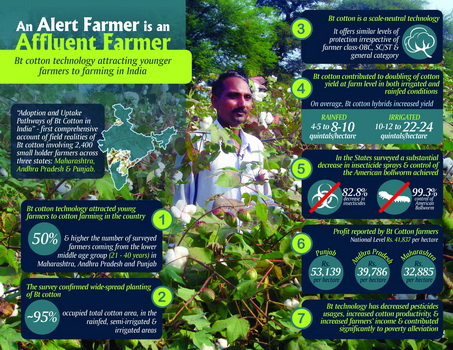
ISAAA Produces Infographic on "7 Wonders of Bt Cotton"
April 2, 2014| |
ISAAA produced an infographic on Bt cotton manifesting the "7 wonders of the Bt cotton" and drawing the key trends in cotton sectoral transformation in India. It is based on the major findings of a report that is a result of the largest and most comprehensive survey involving 2,400 Bt cotton farmers across the three agro-ecologically distinct cotton growing states. The survey focused on 1,000 farmers of rainfed cotton in Vidharbha districts of Maharashtra in Central zone, 1,000 farmers of semi-irrigated cotton in Andhra Pradesh in Southern zone and 400 farmers of fully irrigated cotton area of Punjab in Northern cotton growing zone of the country. The report, published by the Indian Society for Cotton Improvement (ISCI), "The Adoption and Uptake Pathways of Bt Cotton in India" co-authored by Dr. CD Mayee and Bhagirath Choudhary is supported by the John Templeton Foundation.
Recognizing the importance of knowledge sharing as a critical component of technology adoption, dissemination, farm prosperity and poverty alleviation in rural areas, the latest infographic on Bt cotton manifests the "7 wonders of the Bt cotton" in India:
1) Bt cotton technology attracted young farmers to cotton farming, with more than 50% of the surveyed farmers coming from the lower middle age group in the three sites
2) Bt cotton, occupying ~95% of total cotton area, confirms widespread planting in the rainfed, semi-irrigated and irrigated areas
3) Half of the adopters of Bt cotton were small holder cotton farmers from other backward classes (OBC) in Maharashtra, confirming that farmers from lower strata including OBC and SC/ST category, were adopters of Bt cotton. This reinforces the fact that Bt cotton is a scale-neutral technology and offers similar levels of protection irrespective of farmer class
4) On average, Bt cotton hybrids increased cotton yield from 4-5 quintals per hectare to 8-10 quintals per hectare in rainfed conditions. In irrigated areas cotton yields showed a steep increase from 10-12 quintals per hectares to 22-24 quintals per hectare
5) A substantial decrease of 82.8% in insecticide sprays was realized in Bt cotton, whilst achieving 99.3% control of the American bollworm pest. Farmers in Maharashtra reported 78% reduction in insecticide sprays, 82% in Andhra Pradesh and 98% in Punjab
6) Bt cotton farmers reported an average net profit of Rs. 41,837 per hectare at the national level. The highest profit was in the Punjab at Rs. 53,139 per hectare followed by Rs 39,786 in Andhra Pradesh and Rs. 32,885 per hectare in Maharashtra
7) Bt technology has decreased pesticides usages, increased cotton productivity, and increased farmers' income and contributed significantly to poverty alleviation.

A high resolution copy of infographic is available for free download at http://www.isaaa.org/resources/infographics/affluentfarmer/affluentfarmer.jpg. The ISCI survey report "The Adoption and Uptake Pathways of Bt Cotton in India" is available in the form of executive summary and full report at ISCI and ISAAA websites http://www.isaaa.org/programs/specialprojects/templeton/adoption/default.asp and http://www.isaaa.org/india. You can obtain a hard copy of ISCI survey report by placing an order to charumayee@yahoo.co.in or b.choudhary@cgiar.org.
| |
Biotech Updates is a weekly newsletter of ISAAA, a not-for-profit organization. It is distributed for free to over 22,000 subscribers worldwide to inform them about the key developments in biosciences, especially in biotechnology. Your support will help us in our mission to feed the world with knowledge. You can help by donating as little as $10.
-
See more articles:
-
News from Around the World
- New International Partnership Aims to Increase Wheat Yields
- ISAAA Report on GM Crops Launched in Burkina Faso, South Africa, and Kenya
- Uganda Launches 2013 Global Status Report
- UN Announces First Countries Set to Benefit from African-Led Food Security Fund
- FAO DG: Africa's Youth Key to Strengthening Agricultural Economy
- ACSH Releases New Publication on GM Food
- Engineered Bacteria Produce Biofuel Alternative for Rocket Fuel
- Philippine DA Regulators and Crop Researchers Train on Biotech Communication
- Vietnam's Regulatory Circular to Take Effect
- GEAC Allows Field Trials of 11 New Varieties of Biotech Crops in India
- BARI DG Faced the Media on Bt Brinjal Commercialization
- ISAAA Produces Infographic on "7 Wonders of Bt Cotton"
- Scientists Identify Sugar Transporter for Nectar Production
-
Research Highlights
- GOLDEN2-LIKE Transcription factors: Keys to Tomato Development
- Genetic Analysis of Verticillium Wilt Resistance in Biotech Cotton
-
Beyond Crop Biotech
- Study Finds Math Anxiety Can be Due to Genetic Factors
- OSU Scientists Discover Protein Linked to Spread of Breast Cancer Cells
-
Announcements
- Synthetic Biology Congress
- World Congress on Industrial Biotechnology
-
Resources
-
Top Ten Facts on Global Biotech/GM Crops 2013 in 52 Languages
-
Read the latest: - Biotech Updates (November 12, 2025)
- Gene Editing Supplement (October 29, 2025)
- Gene Drive Supplement (February 22, 2023)
-
Subscribe to BU: - Share
- Tweet
